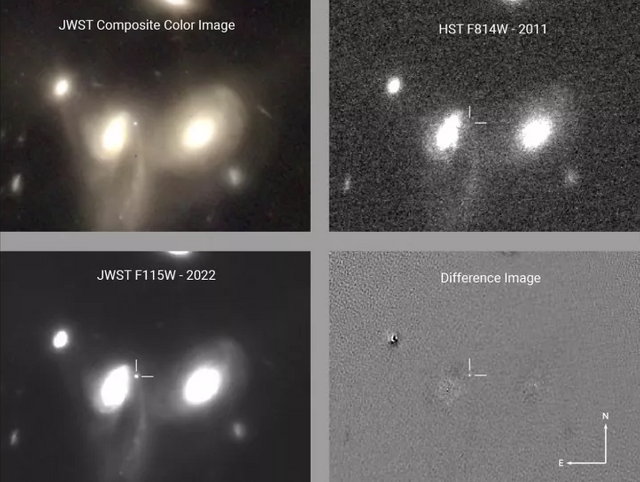James Webb Space Telescope detects a surprise supernova
The detection promises to open up a completely new area of research possibilities.
The James Webb Space Telescope has surprised scientists by unexpectedly detecting its first supernova, an explosion of a dying star. The detection could possibly open up an entirely new area of research possibilities, scientists say.
Just a few days after the start of its science operations, the James Webb Space Telescope's NIRCam camera spotted an unexpected bright object in a galaxy called SDSS.J141930.11+5251593, some 3 to 4 billion light-years from Earth. The bright object dimmed over a five-day period, suggesting that it could have been a supernova, caught by sheer luck shortly after the star exploded. (The astronomers compared the new observations with archived data from the Hubble Space Telescope to confirm the light was new.)
The discovery is surprising as the James Webb Space Telescope wasn't built to search for supernovas; a task usually performed by large-scale survey telescopes that scan vast portions of the sky at short intervals. Webb, on the other hand, looks in great detail into a very small area of the universe. For example, the deep field image released by U.S. President Joe Biden in mid-July, covered an area about as large as a grain of sand.
Since the detection(opens in new tab) came already in the first week of Webb's science operations, astronomers think that the depth of Webb's images might actually compensate for the small area. Each deep field image includes hundreds of galaxies — which means hundreds of opportunities to spot a supernova.
The early detection suggests the telescope might be able to see supernovas on a regular basis, according to Inverse(opens in new tab). That would be exciting, particularly because Webb is expected to see the earliest galaxies that formed in the universe, in the first hundreds of millions of years after the Big Bang. Combine that ancient view with its unexpected supernova detection and Webb might be able to capture the explosion of one of the first-generation stars that lit up the universe after the dark early ages. These stars, astronomers think, had a much simpler chemical composition than stars that were born in later epochs.
"We think that stars in the first few million years would have been primarily, almost entirely, hydrogen and helium, as opposed to the types of stars we have now," Mike Engesser, an astronomer at the Space Telescope Science Institute, which operates Webb, who led the team that announced the detection, told Inverse. "They would have been massive — 200 to 300 times the mass of our sun, and they would have definitely lived a sort of 'live fast, die young' lifestyle. Seeing these types of explosions is something we haven't really done yet."
The supernova detected marks the death of a much younger star, one only 3 to 4 billion years old, but it's a promising start for a telescope built to do something rather different.
Supernovas are tricky to detect since the explosion itself lasts only a fraction of a second. The bright bubble of dust and gas that these stellar deaths generate fades after only a few days, so a telescope needs to be looking in the right direction at the right time to catch one.
Now astronomers must hope that Webb's first supernova wasn't just beginner's luck!
( )
)
The supernova is visible in the Webb images as a small bright dot on the right of the big bright spot on the left. (Image credit: Space Telescope Science Institute)